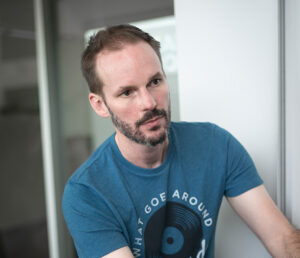
Article
The Power of Thinking Small: What established corporations can learn from agile consumer product companies
It's time to think about product design differently. Discover secrets to success in the consumer industry that you can apply at large B2B companies too.
One of the most interesting things about working at a design consultancy like M3 is the variety of industries you’re exposed to every day. One day you might be sketching the next big consumer electronics product or children’s toy while the next you might be brainstorming ways to engineer a complex robot or reinvent the pharmaceutical industry. Mix the diversity of projects with the variety of backgrounds of every designer and engineer in the office, and the breadth of product development perspectives in a remarkably small radius is actually quite extraordinary.
That wide assortment of experience in many different industries is particularly handy when it comes to solving complex problems. And thanks to compounding issues like product requirements, industry regulations, and corporate politics, the larger the company the greater the challenge. But if you’re working for a large company and have ever felt like you’re designing in a slow-moving mess of connect-the-dot regulations, never-ending market testing, and make-or-break gate meetings, the good news is that there’s hope. Let’s take a break from the TPS reports for a day and think about product design a little differently.
What can large corporations learn from small consumer product companies? At M3 we’ve seen a lot of both sides and can help you navigate the design landscape with fresh eyes. Here are three consistent patterns we’ve seen that separate the agile innovators from the industry heavyweights just going through the development motions.
Your development process is way too slow
Potential clients often like to ask about the typical speed of a new product design process. Medical companies tend to think in terms of years or even decades. Electronics companies operate in critical component cycles measured in months or years. Startups are often month-to-month or as fast as is possible to get to the next funding milestone. So what would you imagine is a typical fast development process of a small consumer product company?
By thinking first about process, you may have already lost the race. While you were debating scheduling rapid stand-up meetings versus detailed off-site planning sessions, your consumer industry counterpart already cut to the chase and took action. Imagine empowering your best handful of designers and engineers to design the next product on the plane to China where they plan to immediately release the parts for tooling. It really happens! That may sound crazy, but time-sensitive projects call for creative solutions.
Now obviously different industries operate at different paces. And the complexities of certain products will never allow for an effective design on a plane ride. Beyond the basic product features, there are often important regulatory requirements and approval steps that simply can’t be expedited. But the honest truth is that the vast majority of corporate product development processes are stuffed with so much administrative waste that doesn’t help the final deliverable in any measurable way.
When is the last time you cancelled a pointless meeting? Why has it been so long?
You’re probably neglecting your most important product
Black Friday and Cyber Monday are holiday staples in the consumer product industry. Specifically designed to drive traffic, these big headliner sales get lots of attention from shoppers eager to find good deals. Have you ever wondered why the front-page items are always TVs, computers, and gaming consoles?
Your first instinct might be that these are all high-dollar items that must make lots of money. But if you’re familiar with retail, you’ll recognize that they’re actually some of the lowest margin products in the store even before the big doorbuster sale. So why do retailers spend so much prime advertising budget pushing low-margin products?
Buy any of those items, take a look at your final cart, and the answer will become quickly obvious. Sure, a TV might not make a lot of money for the store. But the HDMI cable you just got to connect it to your Roku is almost pure profit. The same goes for the new mouse for that laptop and the stack of games for the new console. Consumer product companies sell the big-ticket items sometimes very close to cost to bring in customers with the expectation of making most of their profits off peripheral accessory sales.
The next time you’re working late hours developing a high-priced product while ignoring the accessories that go with it, take a break to think about where your real revenue will be coming from.
Are your efforts appropriately allocated to the most profitable products? Why not?
Focus groups are holding you back
Products are expensive to develop. It’s normal to want to find ways to manage risk of an undesirable product making it to market. To help gauge that risk, an entire cottage industry has sprung up to run focus groups with target customers, elicit feedback, and inform the development process. No product should be designed in a vacuum, and it’s very sensible to seek out outside opinions along the way to make sure you’re on the right track. We do some of that as well and it often is extremely insightful.
But one of the interesting things about the consumer products industry is that there’s really not time to waste on focus groups. A month spent designing the perfect product is a month of missed revenue. And since the entire sales window for some consumer products (like mobile accessories) is fleetingly short, that delay may result in significant percentage reductions in your revenue projections. Try selling that to management!
That said, consumer companies aren’t reckless. They’re just creative in how they manage the risk of product failure. Rather than depend on the opinions of a dozen random strangers to guide the product design, they hire the very best designers already immersed in their target market. And rather than betting the house on one product to carry the company, they produce dozens in parallel. When the product is too complicated to practically make multiple finished versions, they strategically prototype multiple ideas. Then they put them through their paces with critical stakeholders as quickly as possible. Some will fail miserably while others will thrive beyond all projections. In the end natural selection through product attrition will shape their product assortment more quickly and efficiently than millions of dollars in focus groups.
Do you spend most of your effort perfecting one perfect product or developing multiple potential successes at a time? Is that really the most efficient strategy?
I wager at least one of those points hits close to home. Not every organization has the luxury of the freewheeling culture of a small consumer products company, but there’s always some part of the development process that operates on tradition more than a thoughtful decision catered to each project.
So the next time you feel stuck in a rut, try wearing a different hat and challenging that tradition. How might somebody else from outside the building attack the same problem? Answer that, and you’ll unlock a whole new world of possibilities.





